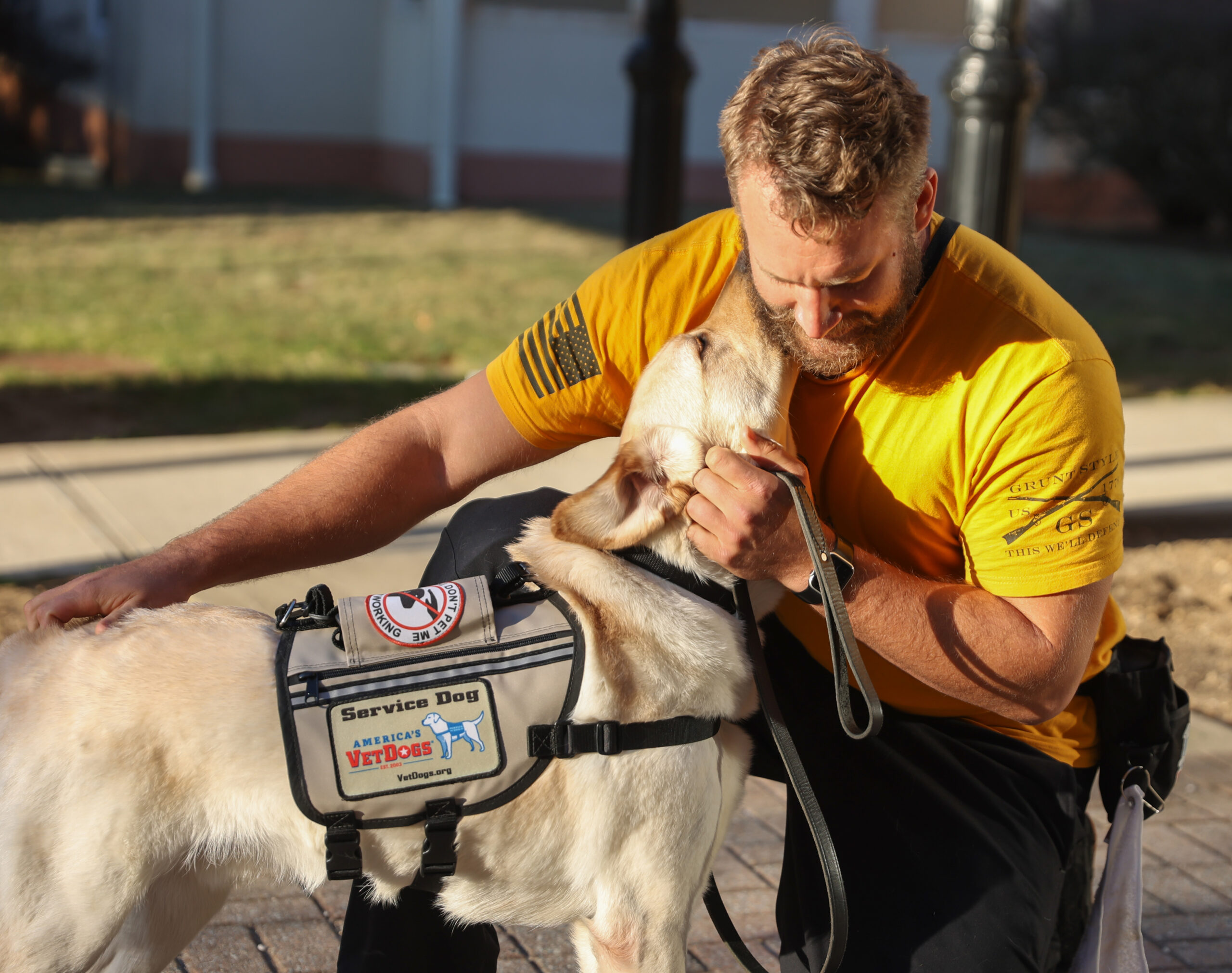“My dog is a lifesaver. He is my life.” – Sean, U.S. Navy Veteran
Veterans give a lot to help protect our country, and that service can come at great cost even after they return home. According to the U.S. Department of Veterans Affairs, between 11 and 30% of combat veterans suffer from post-traumatic stress disorder (PTSD) at some point in their life. Fortunately, there are plenty of other heroes ready to lend a helping paw.
Without help, PTSD can be a chronic and debilitating condition for even the toughest veterans and first responders. PTSD service dogs are one form of treatment that can have a major positive impact on a veteran’s life.
The Benefits of PTSD Service Dogs for Veterans
“Before I got my service dog, there were times I wouldn’t leave my house. With her, every day there’s a reason to wake up.” – Megan, First Responder
Having a dog at home has several documented mental health benefits, but just how much can a service dog positively impact a veteran in need? According to seven peer-reviewed scientific studies supported by the U.S. Department of Veterans Affairs, quite a lot.
The various studies examined the connection between veterans with PTSD and service dogs and discovered that these canine companions provided several major benefits, including:
- Significant reductions in symptoms of post-traumatic stress, perceived stress, isolation, and self-judgment.
- Decreased isolation.
- Lower rates of depression.
- Significant reductions in anger or intrusive thoughts.
- Less time looking at threatening or triggering imagery.
- Lower absentee rates due to health for employed veterans.
Service dogs also do more than reduce some of the more negative aspects of PTSD. Research also shows that these supportive canines helped uplift their veteran companions and enrich their lives in the following ways.
- Increased self-compassion and self-confidence.
- Higher quality of life and social functioning.
- Better ability to stay present and avoid panic attacks and anxiety.
- More confidence to return to work or school.
- Better sleep.
How Do Service Dogs Help with PTSD?
“He gives me the courage to face things and continue to move forward.” – Al, U.S. Marine Corps Veteran
After learning the benefits that service dogs can have for veterans, it’s time to learn how our furry friends can make such a meaningful impact. Each veteran may have different needs, and their service dog is trained to help them with those specific challenges. Thankfully, these heroic canines can provide support for anything ranging from mobility to psychological needs in several ways.
They perform important jobs
Service dogs can be trained to perform a variety of jobs, from assisting with diabetes management to detecting allergens. Dogs being trained for PTSD support undergo special training to match them with veterans. Each veteran may have different physical, emotional, and psychological needs, so PTSD service dogs learn special skills to support their human in a variety of ways. Common jobs for PTSD service dogs include:
- Anxiety interruption and alerts: PTSD service dogs will place their head in the veteran’s lap or nudge them to help dispel any growing anxiety.
- Pressure therapy: Dogs will lay on top of or lean against their veteran to take anxiety interruption to the next level.
- Blocking: Dogs will position their bodies in front of a veteran to create a physical barrier with enough space to help their vet feel more secure.
- Provide cover: Dogs will stay behind veterans and let them know if anyone is approaching or getting too close.
- Medication reminders: Dogs can alert their vets to take any prescription medications in a timely matter.
- Various alerts: If the vet has any medical issues, dogs can alert them during certain events such as blood sugar spikes.
- Nightmare interruption: Dogs can recognize when vets have distressing nightmares and gently wake them up when necessary.
- Mobility assistance: Dogs can open doors, push out-of-reach buttons, and complete other tasks to help vets with motion of balance issues.
They encourage more activity
Pet parents know that dogs need regular exercise, but that extra activity is also beneficial for veterans with PTSD. A published study in the National Library of Medicine evaluated multiple factors to see if they could measure the impact service dogs and pet dogs have on veterans with and without PTSD. According to their tests, veterans with PTSD:
- Walked 14.6% more if they had a pet dog.
- Walked 29.5% more if they had a service dog.
This extra activity is especially important for veterans. According to the U.S. Department of Veteran Affairs, 78% of veterans who receive VA healthcare are either obese or overweight. By encouraging some more activity, dogs can help veterans move around more and stay in better shape than if they were without a canine companion.
They help veterans socialize
Sometimes just having a furry friend nearby can make a major difference for people in need. Having that regular form or comfort and support can help veterans with PTSD get out of the house and meet new people. This process is slow, but that extra time spent meeting others and alleviating anxiety is a noted improvement from isolation.
They give veterans new responsibilities
While service dogs for PTSD have several important jobs, they also help by giving them new responsibilities. According to National Library of Medicine study, one of the most compelling examples of how PTSD support dogs help veterans is that they “help them reclaim control of their life and obtain a sense of worth by promoting responsibility and self-efficacy.” In short, just the act of being a pet parent gives veterans a new sense of purpose by caring for the canine they love.
How to Support Veterans and PTSD Service Dogs
“It’s an amazing gift to all of us. I have my old husband back.” – Anne, wife of Peter, U.S. Army Veteran
PTSD service dogs play an important role for thousands of veterans, and now it’s our turn to help. As the organization celebrates its 20th anniversary, America’s VetDogs has placed more than 1,000 service and guide dogs with veterans, active-duty military, and first responders with physical and emotional disabilities across the country and into Puerto Rico and beyond.
While it is incredibly important, this mission takes time, energy, and money to complete. It can cost more than $50,000 to breed, raise, train, and place one assistance dog, but these services are provided free of charge for the individuals in need. Fortunately, there are ways we can support that noble cause:
“Service dogs save lives and change the lives not only of the veterans, first responders, and active-duty service members we have the honor to serve, but also of their spouses, partners, children, loved ones, friends, and colleagues,” said Mike Rosen, Chief Marketing Officer, America’s VetDogs. “The ripple effects of a service dog are transformational and extraordinary. Our America’s VetDogs treats for dogs let anyone be part of helping to advance our mission to help more of our nation’s heroes who might benefit from a service dog Live Without Boundaries.”
Want to learn more about how else you can make a difference for dogs and veterans? Sign up for the Best Friends Club to receive exclusive email updates, informative articles, and members-only discounts that can support your best friend. Another way to show your support purchase some American Vet Dog Treats!
America’s VetDogs® is a Registered Trademark used under License from America’s VetDogs®—the Veteran’s K-9 Corps®, by Bil•Jac Foods, Inc.







Leave a Reply